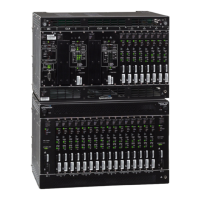12
TimeHub 5500 TL1 Reference Manual
Introduction
097-55501-02 Issue 5: June 2003
SSS SSSSSSS SSSS S SSSSS SSSSSSS S SSS S SSSSS SS
1
Conventions
Uppercase letters in a command designate parameter values which must be
entered as shown. Lowercase letters in a command are the parameter name, and
the specific values that must be entered for the parameter. The Parameters section
of this chapter describes the parameters and the values where a value is the same
for all parameters. Parameter values for a particular command are listed with the
command. The system accepts either uppercase, lowercase, or a mixture of both,
but upper and lower case cannot be mixed within a parameter block.
The following symbols are used in the input and response messages:
[ ] encloses an optional parameter
{ } encloses a group of parameters, at least one of which must be entered
| separates alternatives in a group of parameters, at least one of which
must be entered
^ indicates a space (used in the description of the response format, but
not used in the command responses)
– separates command code fields
: separates parameter blocks
, separates parameters within a block
; terminates a command, and causes execution
" " encloses text to be parsed by a machine
/* */ encloses comments for humans
< > encloses a TL1 named variable
\" \" encloses a description of a condition
... indicates the line in a response may be repeated as required
Parameters
The parameters that may be used in commands, responses, and messages are
defined in Table A. When a parameter uses the same values in every instance,
those values are listed with the parameter in the table. When the context requires
different values for a parameter, the value is listed with the parameter in the
applicable commands, responses, and messages.

